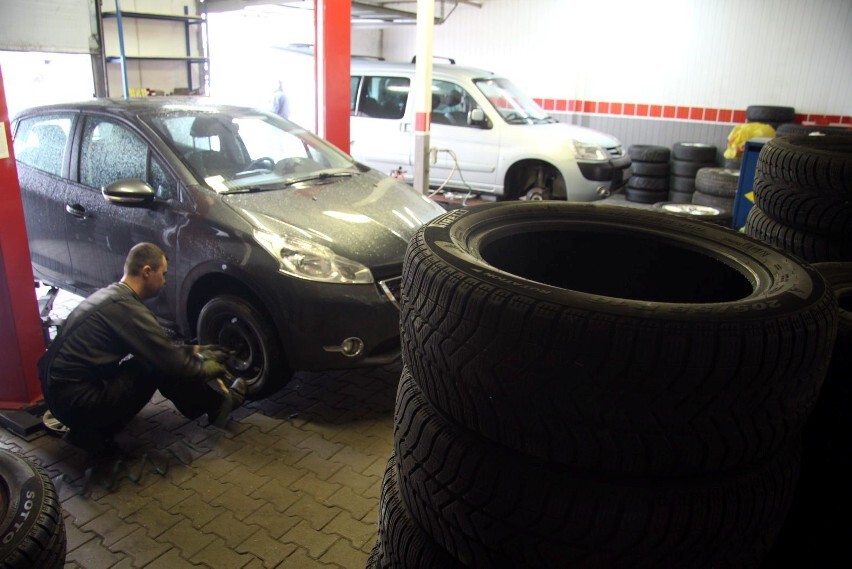
Tire change. What do drivers forget about when switching to winter tires?
Content
 Although in Poland there is no legal obligation to change winter tires, it is assumed that drivers regularly take care of this for the sake of road safety. However, before taking your vehicle to a vulcanizer, there are some important things to consider.
Although in Poland there is no legal obligation to change winter tires, it is assumed that drivers regularly take care of this for the sake of road safety. However, before taking your vehicle to a vulcanizer, there are some important things to consider.
Proper storage of tires
Visiting the vulcanizer in the spring is connected with the fact that we are reaching for summer tires, and then we put the winter tires in the basement or garage, where they wait for the next season. Unfortunately, not every driver stores them properly. It should be ensured that they are in a well-ventilated area, have dry air (preferably up to 70% humidity) and the absence of excessive solar radiation. The temperature should be in the range from -5 to +25 degrees C. For storage of tires, you can use special bags that protect against harmful external factors.
Tires with rims can be stacked, preferably on a smooth and clean surface, or hung on specially designed hangers. Without rims, preferably vertically.
Installing Straight Discs and Tightening Screws
Before changing tires to winter, you need to check the condition of the disks. It is best to take care of their cleanliness in advance, apply polishing agents and polish the surface. Fresh dirt, grease or brake fluid residues are removed much more easily than already dried ones. Just before installation, check that the discs are straight. When changing tires, tighten the bolts in the correct sequence with a torque wrench. An experienced vulcanizer knows perfectly well how hard to do it. A seasonal tire change is also a good time to replace your car's valve with a new one, so keep this in mind when visiting a specialist.
- A very important point when changing tires seasonally is to check the tightening of the bolts after driving 50-100 km from the moment of the visit to the service. More and more tire companies are beginning to inform their customers about this. Although reputable services always tighten the screws with a torque wrench to the appropriate torque, there is a chance that the screw will loosen. A wheel drop is unlikely, but damage to the rim and suspension components could occur.” adds Oskar Burzynski, Sales Specialist at Oponeo SA.
Wheel balancing
Tread wear or improper storage of tires with rims are just some of the causes that contribute to improper weight distribution in the wheel. As a result, characteristic vibrations of the body and steering wheel can occur, which reduces driving comfort, but also affects road safety and faster wear of bearings and suspension elements. That's why it's worth balancing your tires every season. It is useful to visit the vulcanizer after every 5000 kilometers traveled or in exceptional cases, for example, after falling into a pit or after a traffic accident.
Self-changing wheels without experience
Some drivers decide to change the wheels themselves, making many mistakes. Among them, most often there is a problem with tightening the screws. As we already mentioned, this must be done with a torque wrench. They must not be tightened either too tight or too loose. The wheels must also be inflated to the correct pressure and balanced. Only then will they provide you with proper safety and driving comfort.
And most importantly - the condition of the tires
Every driver should pay attention to the condition of their winter tires. Some automotive experts say 10 years of use is the upper limit of safety. Unfortunately, it is impossible to specify a specific age that a tire must reach in order to become unusable. You should definitely check its condition just before putting it on. In addition to the production date, it is extremely important in what road and weather conditions it was used. In addition, it is important how tire maintenance looked like. It consists in thorough cleaning (for example, from chemical residues), drying and fixing with a special preparation. Also remember that damage is best seen on a washed tire surface.
It is suggested that after 5 years of using winter tires, every driver should take extra care and closely monitor their condition. If you do not want to do it yourself, use the help of specialists. For your own safety, if you are not sure, it is better to replace them with new ones. After all, old and worn tires greatly affect driving performance. Any sign of valve damage, cracked fragments, driven nails, or a tread that is too shallow determines how the tires will handle difficult conditions. Although Polish law requires a minimum of 1,6 mm. tread, you should not treat it as a safety limit and bring the tires to such a state. In addition, an old, weathered or hardened compound can adversely affect traction in difficult conditions such as cold weather or snowfall.
Source: Oponeo.pl
See also: Electric Fiat 500
